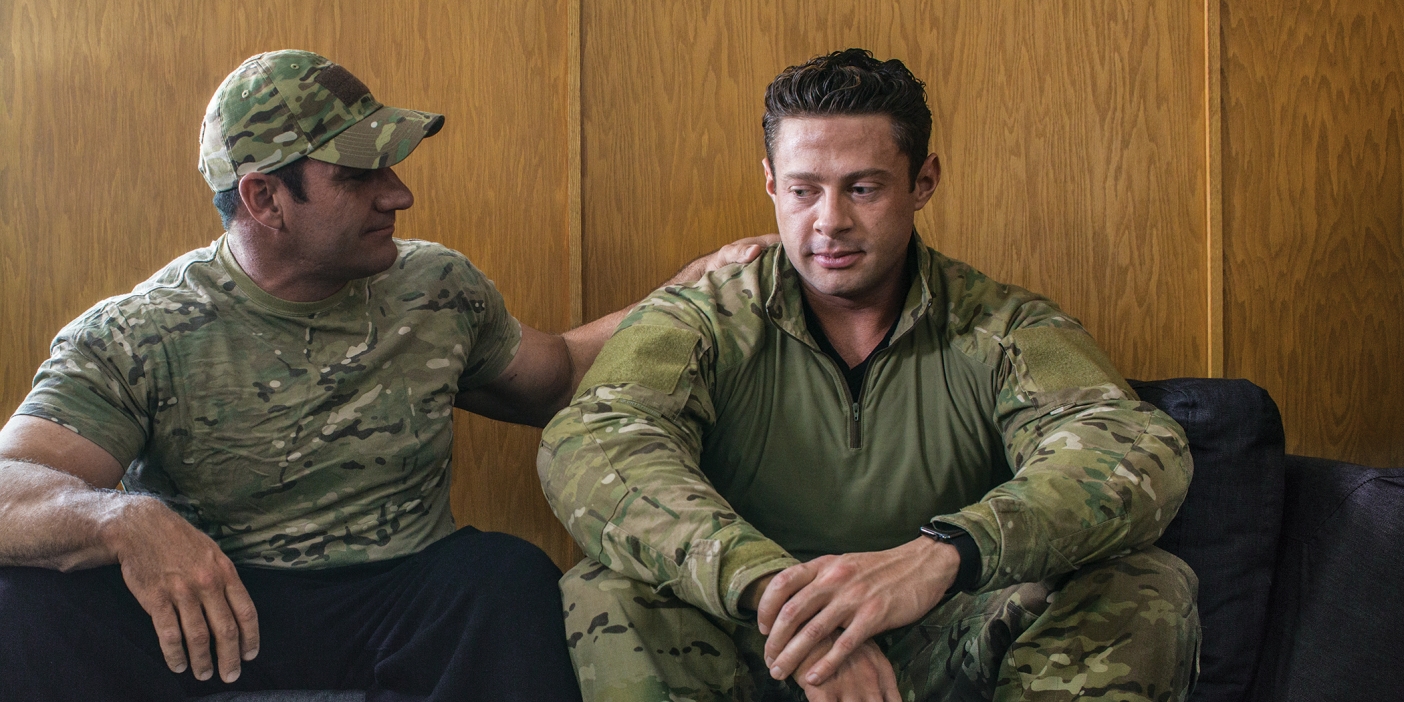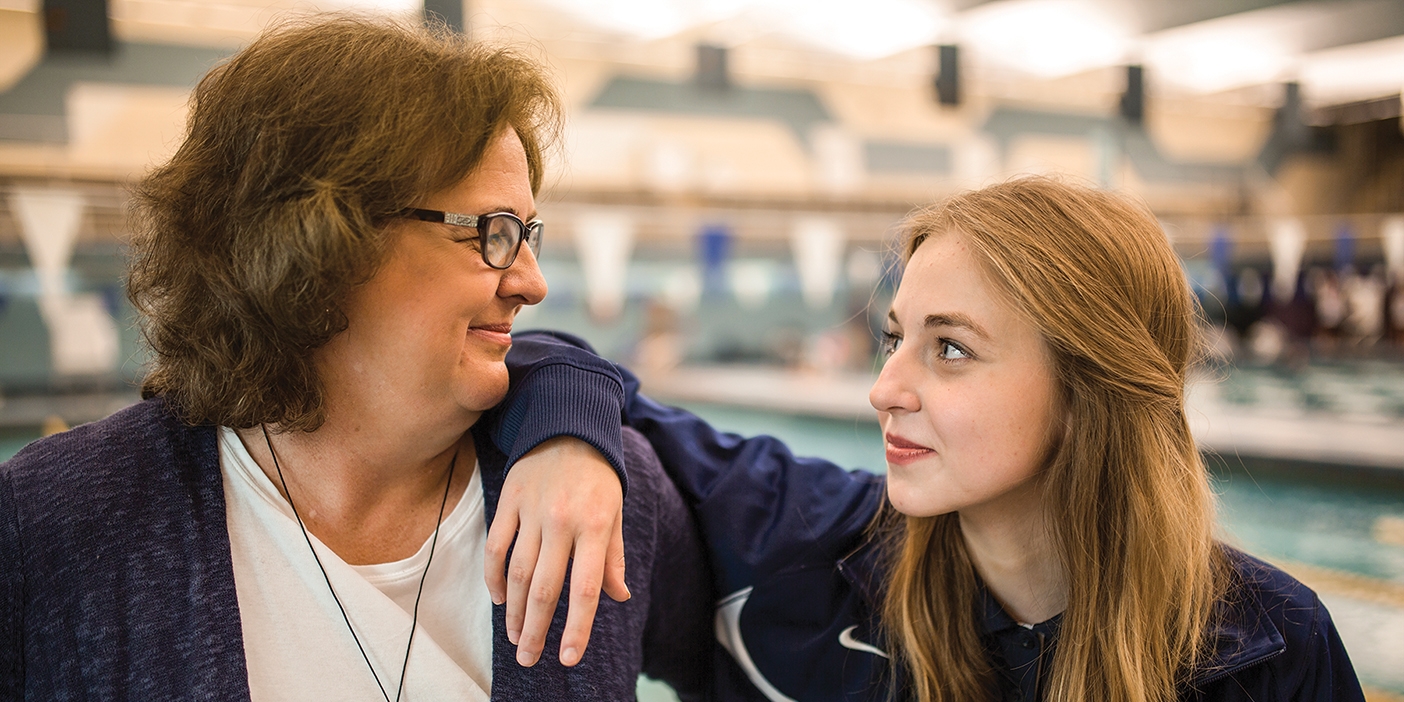Arm Your Kids for the Battle
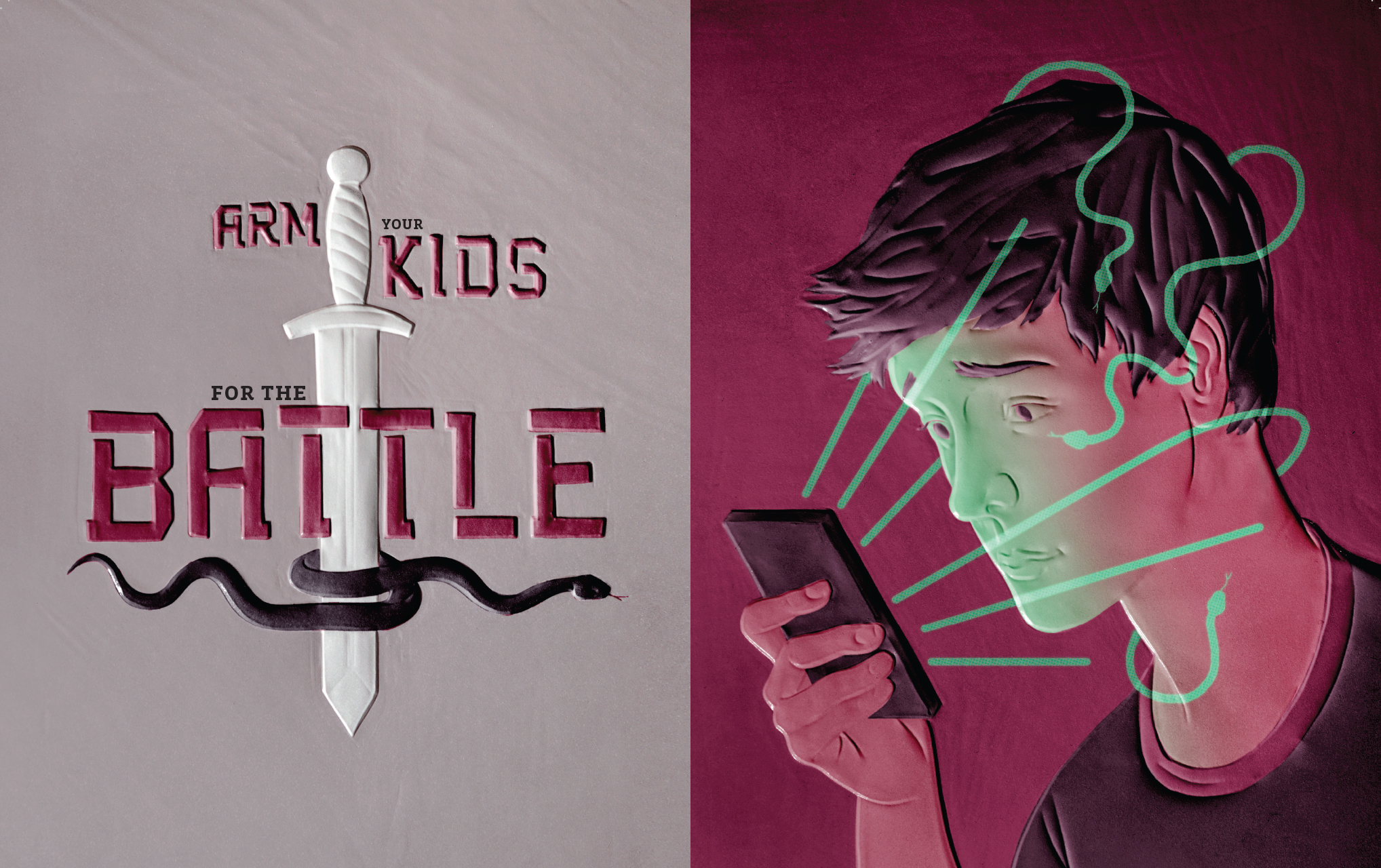
Despite parents’ best efforts, pornography continues to slither into children’s lives. BYU experts share five ways to help kids in their fight.
By Lisa Ann Jackson Thomson (BA ’95, MA ’98) in the Spring 2015 Issue
Illustrations by Alex Nabaum
Kim Turner has a bit of a rep. When she locks the car doors and begins driving around the block, her four daughters know they are in for a talk. Turner’s 19-year-old screams and bangs her hands on the windows in a mock plea for escape. The 17-year-old, on the other hand, is all ears and more than willing to engage. Her 13- and 10-year-olds, used to it by now, just go with it. They are locked in a moving car, after all.
“It’s really the best place to talk to them,” Turner reasons. “No one can escape.”
Turner realized years ago she had to start talking with them about all sorts of issues—including their bodies, sexuality, and pornography. “It just hit me one day that . . . my girls have the wrong sources pleading their case in their faces every day,” Turner says. “They need to have the right sources telling them our case and why we believe this.”
When it comes to pornography, BYU professors say parents need to take an up-front approach. Filters and mere avoidance aren’t enough to protect today’s children. “We can’t do what people used to do. It doesn’t work anymore,” says Richard Neitzel Holzapfel, professor of Church history and faculty advisor to the BYU student club Unraveling Pornography. “We cannot be ostriches and put our heads in the sand.”
Rather, parents need to accept that “kids will and must confront and deal with pornography,” says BYU family life professor Jason S. Carroll (BS ’96, MS ’98), who has studied emerging adulthood, pornography and sexual patterns, and raising sexually healthy kids. “It won’t be enough for us to cocoon them. We must pre-arm them.”
The State of the Battle
Ready to feel overwhelmed? Try taking a glimpse at the current state of pornography. First, there’s the sheer volume. Globally, porn is a $97 billion industry and can be found on hundreds of millions of pornographic Web pages. Extremetech.com reports that pornography accounts for approximately 30 percent of all data transferred over the Internet. And, despite a no-porn policy, social-media giant Facebook has become one of the Internet’s top spots for exchanging explicit images, according to both the National Center on Sexual Exploitation and Morality in Media. Other popular sites like Twitter and Tumbler don’t bother with no-porn policies.

Then there’s the content. The nature of pornography continues to devolve. What was once considered hard-core pornography is now considered soft core. What was once considered soft core can now be found in magazines and catalogs and on prime time TV. And today’s hard-core pornography is more violent, deviant, and obscene than ever.
Then there’s societal acceptance. Jumbo Times Square billboards, international best sellers, a newly launched film festival dedicated to pornography as art, and inclusion in sex-education curricula all demonstrate the place pornography seems to have taken in society. In a 2008 study of U.S. young adults coauthored by Carroll and several BYU colleagues, 87 percent of men and 31 percent of women reported using pornography, and 67 percent of men and 49 percent of women thought viewing it was totally okay.
But then there’s the impact. Studies continue to demonstrate that porn use is anything but okay. Research has linked pornography to sexual violence and deviance, divorce, negative attitudes toward women, and lower marriage rates in young men, who cited viewing pornography as a lower-risk activity than getting into a relationship with a real person. Pornography users are more likely to have low self-esteem and less likely to describe their marriages as happy or to consider extramarital relationships as negative.
Recent headline-grabbing studies indicate that viewing pornography has an impact on the brain’s release of pathway-altering chemicals similar to that seen in use of stimulant drugs.
The evidence is clear: despite widespread acceptance, porn is having broad negative effects on users, their loved ones, and society. “Think of our experience with smoking,” says Robert M. Daines (BA ’89), a Stanford law professor whose statistical study with University of Michigan business professor Tyler G. Shumway (BA ’91) linked sales of Playboy to divorce. “At first, people defended smoking as an individual choice but later came to see that even secondhand smoke harms others. Pornography is like secondhand smoke: it hurts others.”
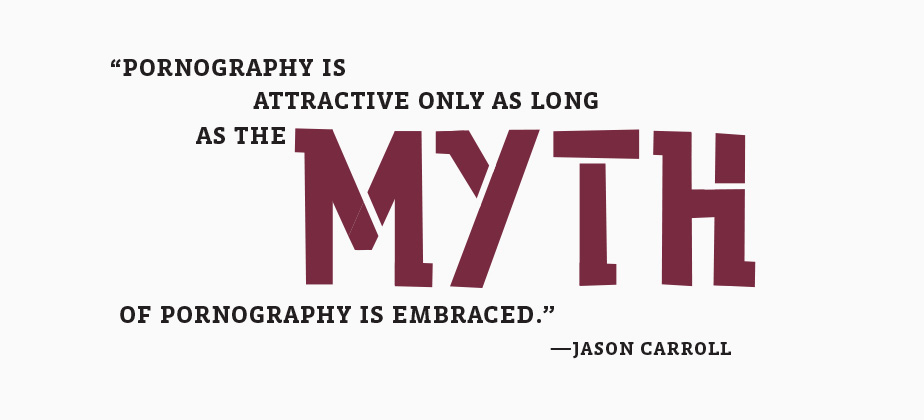
Finally, there’s the access. As early as 2002 the London School of Economics reported that 90 percent of children ages 8 to 16 years old had viewed pornography online, in most cases unintentionally. Today, with 95 percent of U.S. teens using the Internet, pornography has never been easier for kids to access, and studies document the average age of first exposure as 12 years old.
Carroll says mobile devices are the latest front: 78 percent of U.S. teens have a cell phone. “Parents are losing this in . . . the cell-phone battles,” Carroll says. “Kids are getting a lot of access parents are clueless about.”
With access to pornography in their pockets and purses, “it’s ultimately going to become about internal regulation,” says Carroll. “It’s going to be about choices kids make, material they turn away from, and an understanding of what it is they are seeing.”
The stats on pornography may seem daunting, but parents can do more to fortify their kids than they might realize. Here are five proactive strategies parents can employ.
1. Don’t Abandon the Outer Defenses
The first strategy is a familiar one: protect children from encountering pornography for as long as possible.
The brain, says Carroll, has a gas pedal and a brake. The brain stem, home of the pleasure centers, is the gas pedal, and it develops early; only later in the teen years does the frontal cortex, with its reasoning and decision-making abilities—the brake—fully develop.
“Kids have the gas pedal without the full brake,” he explains. That’s why external, third-party monitoring is crucial for young people. “We safeguard our children until the time they can safeguard themselves.”
And research suggests that the longer children can avoid their first exposure to pornographic material, the more prepared developmentally they will be to process and deal with what they eventually see.
“Postponing exposure is helpful, not only for the avoidance of addictive habituation, but also because it allows . . . healthy development to take place,” says BYU family life professor Mark H. Butler (BA ’86, MS ’90), who studies recovery from addictive desires and behaviors.
A few simple steps and reasonable rules can protect children from unintentional exposure and help them think twice about the content they choose to view: using filters (at the computer, router, and even Internet-service-provider levels), keeping computers in common areas, having kids turn in their devices at night, setting parental controls on device access, and having an open-book policy (parents can read texts and social-media posts at any time).
2. Replace Myth with Truth
As Turner realized with her children, BYU researchers say it’s not enough to simply label pornography as bad; parents also need to teach their children what is good. “As we talk about pornography as bad and horrible, children and teens can hear us sending the message that sex in and of itself is bad and horrible,” says BYU professor of teacher education Bradley R. Wilcox (BS ’85), who has taught maturation clinics and authored several books on discussing sexual development with children. “Our kids need to understand the role of real love in a real marriage, creating and strengthening a real family.”

Butler says teachings about sexuality should contain both a witness and a warning. “The sexual-response cycle exists naturally in us as human beings,” he explains. “The desire and drive we have is a God-given endowment which blesses us, drawing us naturally and affectionately toward the opposite sex, toward marriage, and toward family life. That is the witness.”
The warning is that such expressions must be disciplined and kept within the bounds the Lord has set, says Butler. “As puberty happens, the sexual-response cycle naturally evolves and boys and girls discover ways to . . . have ‘feel-good experiences,’” he explains, noting that parent-child conversations are particularly helpful to sort through these new feelings.
But parents need not wait until their children reach puberty to begin discussing sex. Carroll says that by age 8, a child is able to develop a basic understanding of sex in its spiritual, emotional, and relational contexts. He recommends parents help their kids develop a healthy understanding of their body, using correct terminology for body parts and answering questions in simple terms that convey an openness and comfort with the subject matter.
While the content of these conversations is important, Carroll says parents should also pay attention to the context. “Do everything possible not to ritualize these conversations,” he says, noting that parents tend to make it “The Talk.” “We send the siblings to go have a sleepover, we take our child out to dinner, we put on our church clothes, we do it in the parking lot of the temple,” he says. And kids get the message that sex can be discussed only under those circumstances.
Much better, he says, is creating an ongoing dialogue and opportunities for children to ask questions whenever they have them. “If the conversation happens sitting on the bedroom floor or in the pickup truck or out picking strawberries in the backyard, they know how to get back there.”
Wilcox adds, “Children and young people are naturally curious. If we don’t satisfy that curiosity they will often turn to other sources of information.”
Including pornography. In a 2014 study of young adult men, respondents cited pornography as a primary source of sex education.
“Pornography is not sex education,” Wilcox insists. “It is actually sex miseducation marketed for financial gain.”
Thus part of a parent’s instruction is breaking down the powerful myths presented by pornography. “Pornography is attractive only as long as the myth of pornography is embraced,” Carroll says. “If you see the images presented for what they really are, there’s nothing arousing about it.” Behind the scenes are accounts of physical abuse, drug abuse, STDs, unwanted pregnancy, coercion, and even sex slavery.
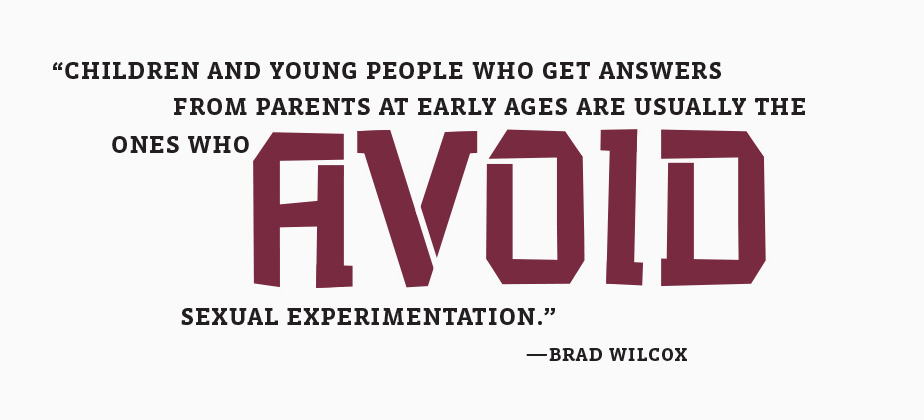
In discussions about pornography, parents can point out that the sexual behaviors portrayed are neither normal nor a reflection of what should be anticipated or expected in a healthy sexual relationship. In the words of a Witherspoon Institute report, pornography is “non-normative people engaging in non-normative acts.”
Parents can find supportive voices in organizations like Fight the New Drug, a young-adult-led anti-porn campaign for which Carroll serves as a research consultant. With slogans like “Porn Kills Love,” “Don’t Take Fake,” and “Don’t Fill Your Head with Lies,” the organization strikes at the heart of the myth, depicting porn as decidedly unrealistic, unhealthy, and uncool. They get the message out through blunt school presentations, a website full of research about how pornography harms, a spirited social-media campaign, and anti-porn swag for teens to purchase and proudly display.
“Sometimes we feel that by answering questions frankly about sex we are condoning promiscuity,” says Wilcox. “My experience has taught me that the teenagers who are the most sexually active are usually the least informed. Children and young people who get answers from parents at early ages are usually the ones who avoid sexual experimentation.”
3. Diagnose a Problem Correctly
Addiction is a word often used to describe the dangers of pornography, and addiction is indeed a dangerous potential outcome of regular pornography use. Butler points out that, unlike addictive substances (such as alcohol or drugs), pornography stimulates the sexual-response cycle that exists naturally within us. Engaging in pornography can hijack the natural reward systems of the brain, which in turn can become reinforcing and addicting.
However, experts warn against jumping too quickly to the conclusion that any involvement with pornography necessarily indicates an addiction.
“Young men and young women get involved with pornography out of curiosity, out of accessibility, and out of what, at its core, amounts to immaturity,” says Carroll. “Every one of us experiences the power of the sexual response triggered during puberty, long before we have the emotional or spiritual maturity to fully make pure sense of it.”
But, he says, “if we move too quickly to assume that any involvement is an addiction, we actually are going to shut down our ability to have openness and dialogue, and often the problem goes underground.” He likens it to leprosy, where sufferers were stigmatized and sent away to live apart from society. “You know what happened when someone got a rash?” asks Carroll. “They hid it for fear of having leprosy and being sent away.”
“Some youth have developed . . . ‘rashes,’” he says. “If the only message is addiction, it gets hidden. It gets tucked away.”
Butler suggests parents take a triage approach when helping youth with pornography problems: How long has it been going on? How often do they view it? How are they accessing it? Then they can work with the youth to determine an appropriate level of action—from having regular follow-up parental conversations to enlisting ecclesiastical help to participating in the Church’s Addiction Recovery Program to engaging a professional therapist.

4. Teach Emotional Management
Beyond natural curiosity, experts say kids often turn to pornography out of an inability to productively cope with negative emotion.
Butler explains it in terms of triggers. “At some point, a young man or woman has a difficult or distressing psychological, relational, or spiritual experience,” he says. And for youth there are a host of potential triggers.
These triggers lead the adolescent brain to seek out feel-good experiences to replace or mask distressing emotions. And therein lies the danger: “The person,” says Butler, “moves . . . into a psychological-dependency orientation. Now he or she is using the behavior as a way of managing life.”
And this can lead to a downward spiral for a youth who is viewing pornography and engaging in related behaviors, such as masturbation, says Tyler R. Pedersen (BS ’94), a clinical professor and the associate director of the BYU Counseling and Career Center. “The individual feels shame over his or her behavior, which leads to more attempts to feel better—including [viewing] pornography—which in turn creates more negative feelings that have to be coped with.”
Counselors like Pedersen and Nathan Acree, manager at a Salt Lake City mental-health facility, say parents can take several steps to help their children develop better coping skills. First off, says Acree, parents should teach children that both good and bad emotions are normal and it is okay to occasionally experience negative feelings such as sadness, anger, frustration, or hurt. Parents, he says, often feel the need to control their children’s emotions, but allowing them to experience and cope with negative feelings builds a critical skill set.
Pedersen recommends parents encourage the child to take active steps to solve the problems contributing to the distress and, when possible and appropriate, reduce the demands on the child. Both counselors suggest parents teach tried-and-true stress-management techniques, such as processing emotions through writing or talking with others, listening to uplifting music, exercising, reading a book, or engaging in a spiritual activity like prayer or scripture study.
Although it is natural for a youth to feel guilt after viewing pornography, parents should take care not to add to the child’s burden by shaming. BYU family life professor James M. Harper (BS ’74, MS ’76) wrote in the book Confronting Pornography (Deseret Book, 2005) on the difference between guilt and shame. He notes that guilt—a recognition that one’s behavior has violated an important standard or value and caused harm to self or others—is a natural, healthy response to mistakes that can motivate change. He contrasts that with shame, which, when internalized, can lead to a sense of hopelessness. “People who experience strong internalized shame view the world through negative, shame-tinted glasses. Every incident in their lives is seen as validation of how worthless they are.”

Harper calls this outlook “an enemy to our belief that all of us are spiritual children of God” and says “it leads to a loss of hope that behavior change can make a difference.”
In addition, shame inhibits the ability to cope with strong emotions or successfully change behavior. “Because shame-prone people doubt emotions and feelings in general, they also doubt spiritual influences,” he writes.
In other words, creating or exacerbating a feeling of shame in a child damages the child’s ability both to develop positive emotional responses and to recognize the influence of the Spirit, which is ultimately the most powerful ally in the prevention of and recovery from pornography use.
One BYU student who struggled with pornography remembered clearly how his parents responded when his challenge came to light: “My mother reacted strongly, yelling and screaming, and it made me feel worse about it rather than hopeful of overcoming it,” he says. “The most helpful was my dad telling me repeatedly how much he loved me.”
5. Practice Developmental Patience
There is no shortage of Church support for parents’ efforts in the fight against pornography. In lessons, talks, and reading materials, youth receive the constant refrain that pornography is an evil to be shunned. But Carroll and others suggest that more emphasis could be given to the doctrine of the Atonement and healthy sexuality. In Latter-day Saint culture, he observes, there are some aspects of the gospel in which we tend to acknowledge the process of progression and there are others in which we seem to acknowledge only perfection.
In relation to pornography, “we rarely hear about a maturation process,” he says. “We all learn through some trial and error in sexual development. It may not all be the same, but everybody, without fail, has some maturity to gain in this part of life.”
Butler believes that the adolescent brain may be one of the primary reasons for the Atonement. “The adolescent brain is not fully formed, and that leads to certain issues like impulse control and lack of forward thinking,” he explains. “A spiritually sincere, striving teen can become crippled by overwhelming guilt when he encounters weaknesses that he is uniquely vulnerable to having with that still-adolescent brain. It is so critical that, alongside teaching the commandments, you teach adolescents the Atonement—that it’s there for the purpose of developmental patience and persistence in life.”
And that is a hopeful message: there is much parents can do to prepare their children to reject pornography, and when they falter, there is an infinite Atonement that makes change and repentance possible.
“There is a light at the end of the tunnel, and it’s not a train,” says Holzapfel. “There is [the light] of a fresh new day, a new beginning, a new start.”


